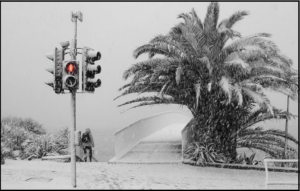This month: Palm colonization, a bit of palm singing in church and still inviting you to join us in Colombia in June!
Palms Everywhere

Even hardy species can’t tolerate prolonged sub-zero temperatures. Here “Date Palm [Phoenix canariensis] during blizzard in Torquay (UK): on 18th March 2018 a blizzard moved in around 10am, and although the intensity lessened about 2 hours later, it continued to snow moderately for about 20 hours.” Photo by Torquay Palms (CC BY-SA 2.0).
Fan Palm), or Washingtonia filifera (California Fan Palm) to name a few, experience shows that even the hardiest palms require that the average temperature of the coldest month be above 2° Celsius (or 36° Fahrenheit).
